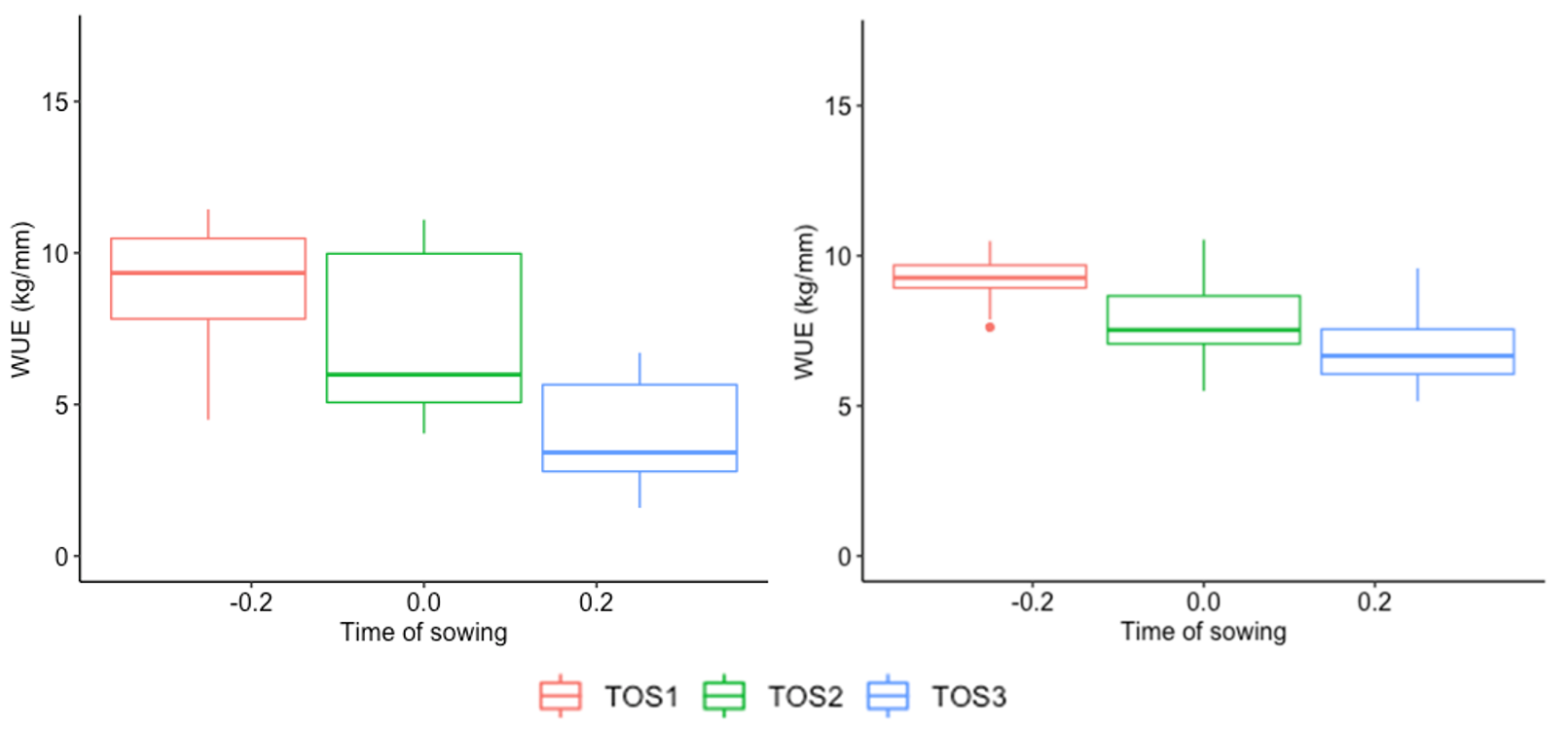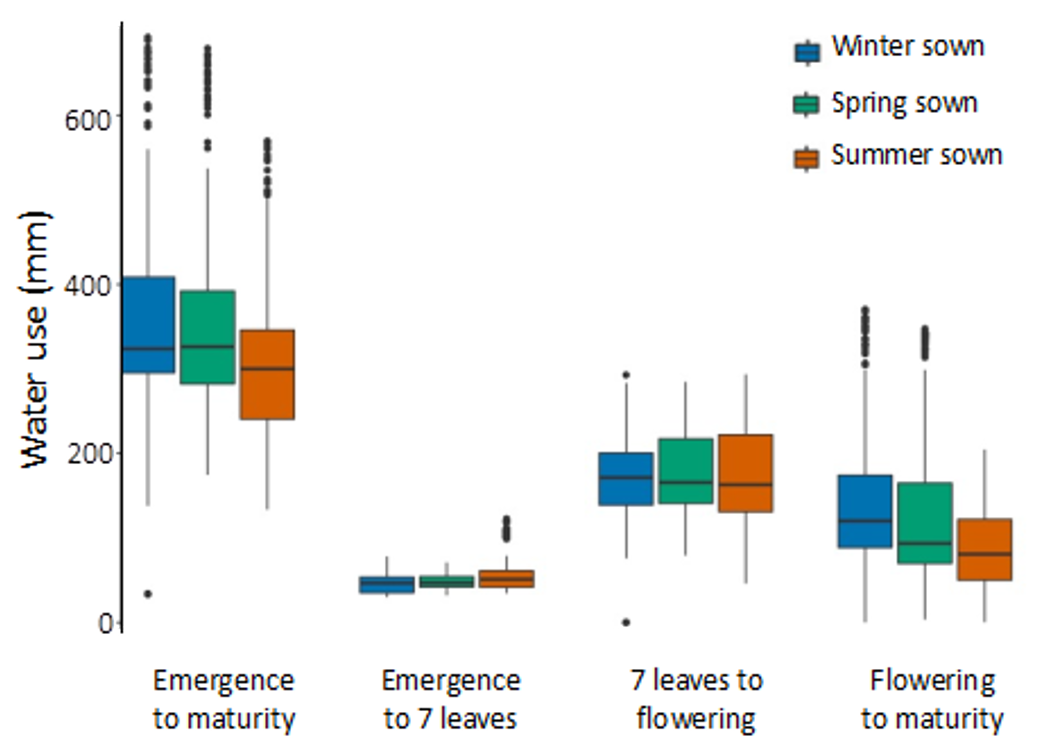Optimising sorghum agronomy in northern NSW and southern Queensland
Author: Loretta Serafin (NSW DPI), Daniel Rodriguez (Centre for Crop Sciences, QAAFI, UQ), Joseph Eyre (Centre for Crop Sciences, QAAFI, UQ), Mark Hellyer (NSW DPI), Paul Murphy (NSW DPI), Malem McLeod (NSW DPI) and Michael Mumford (QDPIF) | Date: 28 Jul 2022
Take home message
- Planting once soil temperatures are at 12°C and rising provides an opportunity for early sowing and establishment of grain sorghum in late winter, with a very low risk of frost damage after 7 leaves or floral initiation
- Early (winter) sown sorghum has an extended period of vegetative growth meaning the crop takes more days to reach flowering, but the flowering window is still 2-3 weeks earlier than a normal spring planting time
- Sowing early reduced the likelihood of heat stress around flowering at most sites. Early sown sorghum also has a lower risk of a dry finish (terminal water stress), which reduces the potential for screenings and minimises or eliminates the risk of lodging
- The yield of early sown sorghum was similar or higher than sowing in spring and summer across all sites from the Liverpool Plains in NSW up to Emerald in Central Queensland
- Water use efficiency (kg/mm) has tended to be higher with early sown sorghum. This is largely explained by the crop growing during a cooler time of the year
- Early sown sorghum used more water than a summer sown sorghum crop. Most of this additional water was used in the flowering to maturity stage to complete grain fill and support realisation of a larger yield potential
- At the cropping system level there is an increased likelihood of double cropping after early sown sorghum, as the resulting earlier harvest increases the opportunity for fallow recharge facilitating short fallowing back into a winter crop
- Analysis of the first two seasons of trials (2018-2020) across 15 sites from the Liverpool Plains in NSW to Emerald in Qld, showed that at each site the combination of hybrid, sowing time and plant population created up to a 66% difference in grain yield.
Background
Australia’s climate has warmed by about 1.4°C since 1910, and an increase in the frequency and intensity of extreme heat and water stress can be expected. The main challenge of growing a profitable sorghum crop in the Northern Grains Region is the need to avoid periods of extreme heat around flowering and reduce the likelihood of water stress between flowering and grain fill. Extreme heat at flowering causes pollen sterility that reduces grain number, the main determinant of final yield. In addition, water stress during grain filling will increase screenings affecting sorghum grain quality and may also induce lodging.
One adaptation tool to reduce risk in sorghum involves moving the planting window earlier into late winter. The main aim being to avoid the overlap of crop sensitive growth stages with the hottest and driest times of the year.
An earlier planting window also has other benefits, including an increased number of sowing opportunities, higher and more stable grain yields in some sites and seasons, and improved grain quality. Farming system benefits of earlier planting include higher cropping intensity through increasing the opportunity for double cropping after early (winter) sown sorghum.
This paper is a summary of current results from the Optimising Sorghum Agronomy program funded by a collaboration between GRDC, UQ-QAAFI, NSW DPI and QDAF from 2018-2022. The program conducts replicated field experiments in collaboration with farmers from the Liverpool Plains in NSW up to Emerald in Central Queensland.
Establishing a uniform crop
Soil temperature
Soil temperatures of 16-18°C have historically marked the start of the sorghum planting window. Results from this project have supported the idea of moving the planting window earlier into late winter (from mid-August) in Southern Qld and Northern NSW if soil temperatures have reached 12°C and are predicted to continue rising for at least 7 days following planting.
Planting into these cooler soil temperatures does mean that the time from planting to emergence is extended, as seedling development occurs at a slower rate. As such, emergence is anticipated to occur in 7-14 days rather than the 3-7 days experienced under warmer soil temperatures (>18°C).
Slow emergence creates an opportunity for increased damage by soil dwelling insects, competition from late emerging winter weeds, and the potential for reduced plant establishment. Selecting suitable paddocks with low weed burdens and treating seeds with insecticide are important tools to reduce the risk of weed competition and insect damage.
Establishment will also be optimised when adequate seed bed moisture is available for 2 weeks post planting, using quality seed and focusing on planting depth (not too shallow or deep).
When soil temperatures of 12°C, good seedbed moisture and reasonable seed quality are combined, it is possible to achieve plant establishments of commercially acceptable levels, ~ 80% such as at the Mungindi site in 2021/22 (Figure 1).
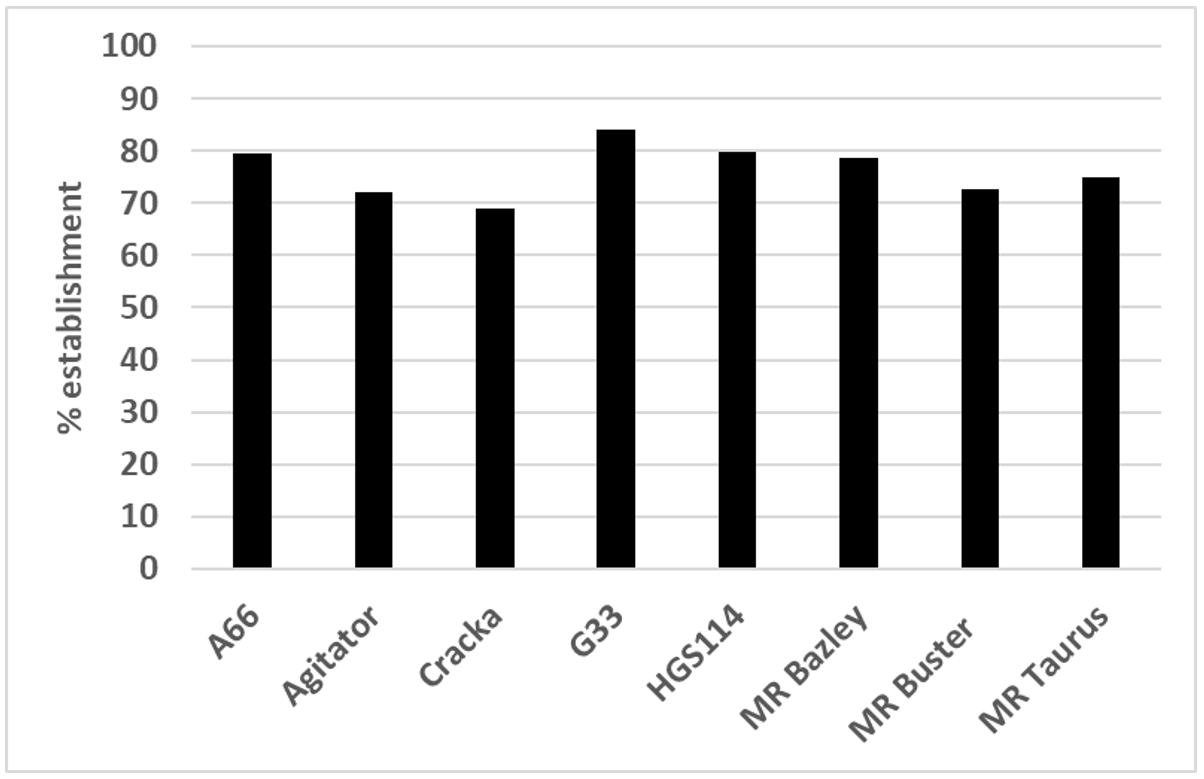
Seed quality
Seed quality varies between hybrids, seasons, and seed batches with all crops. Information on the germination and vigour of sorghum seed to be used for sowing can be useful to ensure establishment is optimised in each planting situation.
The largest factor affecting plant establishment in our trials has been inherent seed quality, i.e., germination and vigour. For example, results of seed quality testing of the trial seed to date have shown high variability in seed lot germination percentages (Figure 2) between hybrids, seed lots and across temperatures. Larger differences in germination appeared between hybrids as the temperature was increased from 15 to 35°C, with germination reducing at the higher temperature (Figure 2).
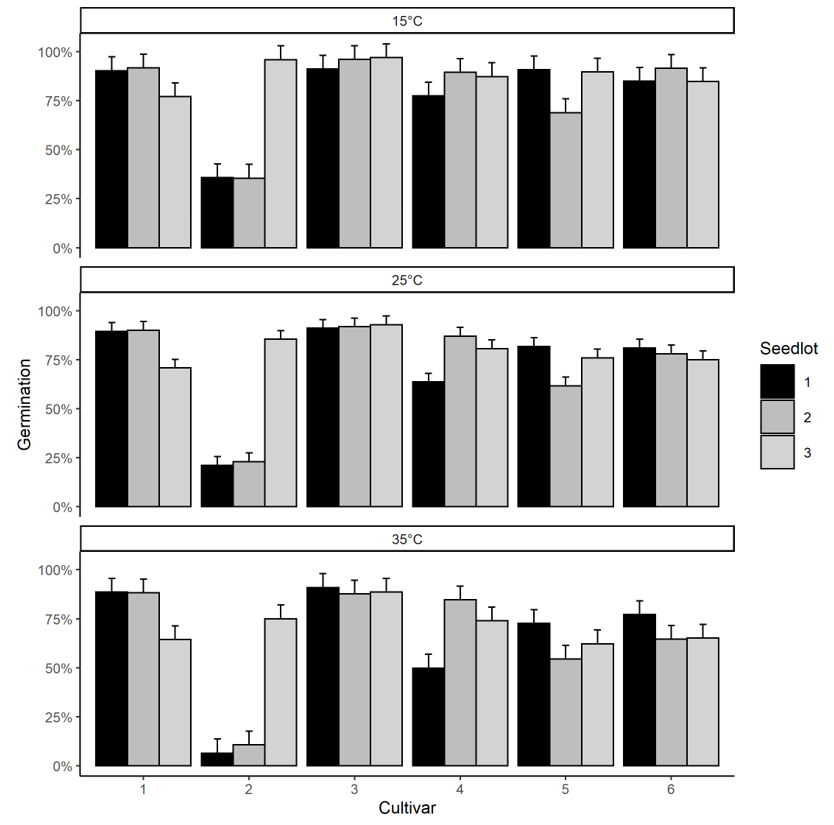
What about the risk of frost damage?
Early (winter) sown sorghum trials have not been significantly damaged by frosts in northern NSW and southern Queensland when planted from early-mid August onwards. Sowing early reduces the likelihood of heat stresses around flowering across most sites, with a very low historical risk of frost damage i.e., frosts after 7 leaves or floral initiation (Figure 3). That is not to say that frost damage will never occur, but the risk is low.
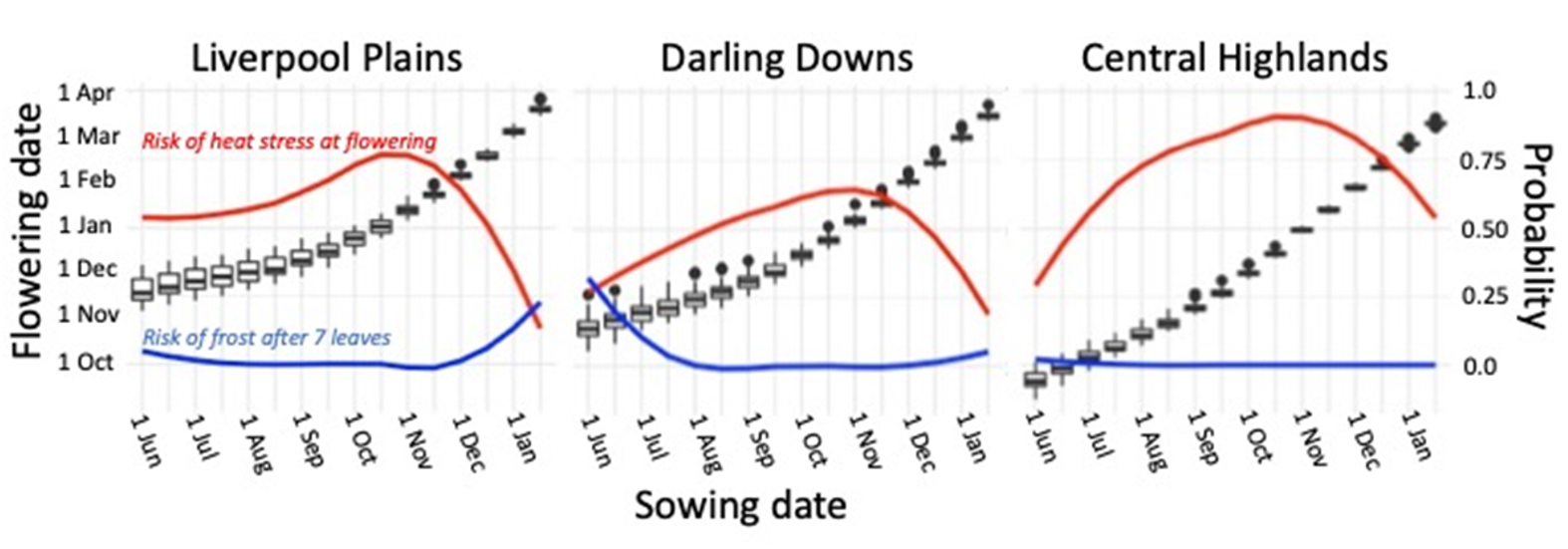
Crop development
Early sown crops grow under cooler temperatures and a lower photothermal quotient. This results in more tillers and longer vegetative and panicle growth stages. As a result, it takes more days to reach 50% flowering when compared to a more typical (later) spring sowing date (Table 1).
Table 1. Days to 50% flowering for eight hybrids planted 11th Sept, 8th Oct and 28th Oct, 2019 at Breeza.
Hybrid/Sowing date | 11th Sept | 8th Oct | 29th Oct |
|---|---|---|---|
A66 | 90 | 81 | 70 |
Agitator | 89 | 78 | 70 |
Cracka | 107 | 90 | 82 |
HGS114 | 91 | 85 | 73 |
MR Bazley | 92 | 83 | 73 |
MR Buster | 96 | 86 | 76 |
MR Taurus | 95 | 85 | 74 |
Sentinel IG | 103 | 88 | 77 |
Even with a longer period to reach flowering, early sowing still moves the flowering window forward. This was demonstrated at “Bogamildi” Moree, when comparing three sowing times (Figure 4).
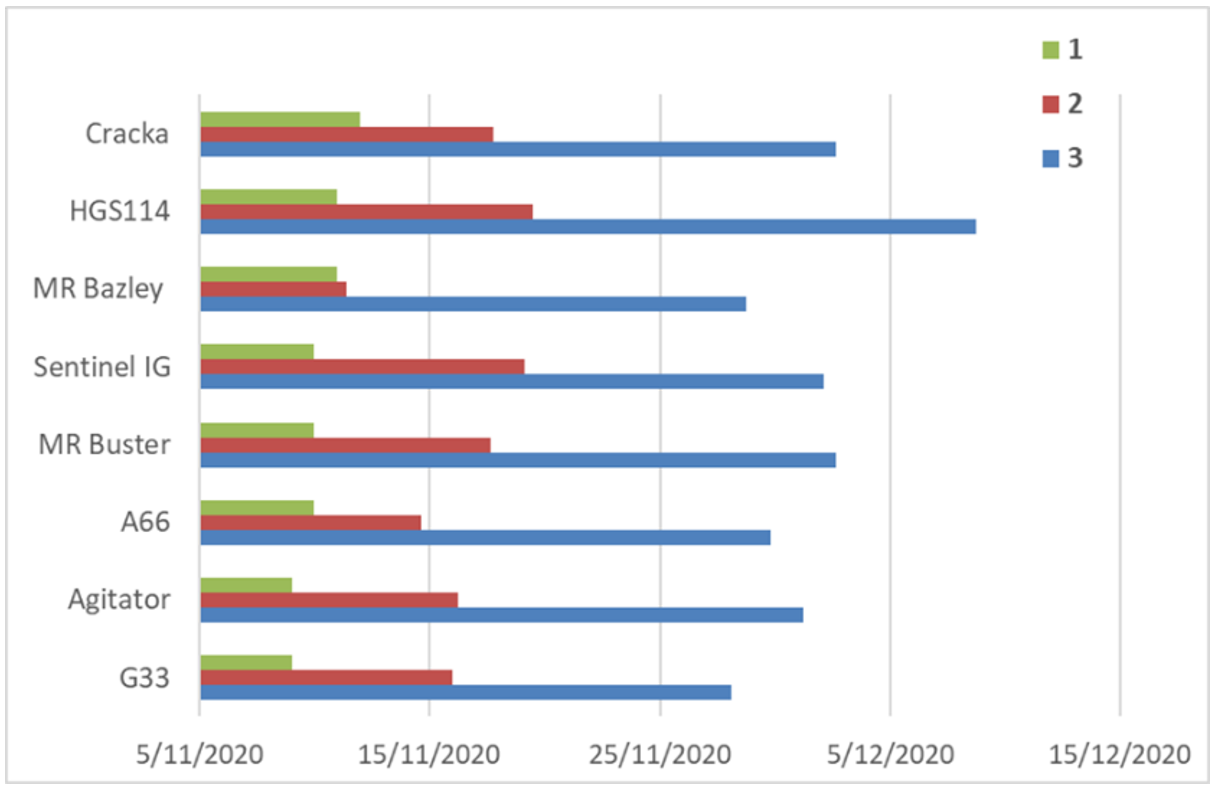
Water Use Efficiency (WUE)
Sorghum is primarily grown in dryland systems, so water use and water use efficiency (WUE) are important measures of crop productivity. Changes in agronomic management, such as shifting the planting window which affect plant development should be expected to have an impact on crop water use.
APSIM was used to simulate the WUE using data from the crop biomass and yield measurements collected from each trial. At both the Breeza and Moree sites (Figure 5), WUE is predicted to be higher from the earlier sowing times. The higher WUE of the early (winter) sown sorghum crop was explained by the crop growing during a cooler time of the year (i.e., lower atmospheric demand), and a relatively smaller canopy size at flowering.
Figure 5. Simulated water use efficiency (WUE) from APSIM using biomass and yield from Breeza (LH) and Moree (RH) trials in 2018-20.
APSIM simulations were also used to compare total water usage. Total water use varied with the planting time and the crop development stage (Figure 6). When collated to produce a total seasonal water use, the two earliest sowings (winter and spring) used more water than the summer sown sorghum. Once this water use was partitioned into the key development stages; emergence to 7 leaves (floral initiation), 7 leaves to flowering, and flowering to maturity, the response varied. In the emergence to 7 leaf stage, more water was used from a summer planting which correlates with higher temperatures and more rapid plant growth rates. In contrast from flowering to maturity, more water is used by the early (winter) sown treatment. Compared to the spring sown crop, the winter sown crop had an additional 30mm of water available in the soil profile which was used between flowering and maturity (Figure 7).
Figure 6. Modelled crop water use (mm) for three times of sowing (winter, spring, and summer) from crop emergence to maturity, emergence to 7 leaves (or floral initiation), 7 leaves to flowering, and flowering to maturity. Results are APSIM simulations for the 15 sites and combined three times of sowing, six commercial hybrids and four plant populations, sown across the Liverpool Plains, Northern NSW, Darling Downs, Western Downs and Central Queensland for the 2018/19 and 2019/20 seasons.
Actual water use was measured in selected treatments at the Breeza and Mungindi sites using a neutron moisture meter. Total water use efficiency was measured at the Breeza (Figure 7) and Mungindi (Figure 8) sites in the 2021/22 season. The overall water use efficiency was slightly higher from the summer planting time at Breeza in this season, which had the benefit of one small flood in early December and in-crop irrigation in mid-January (Figure 7).
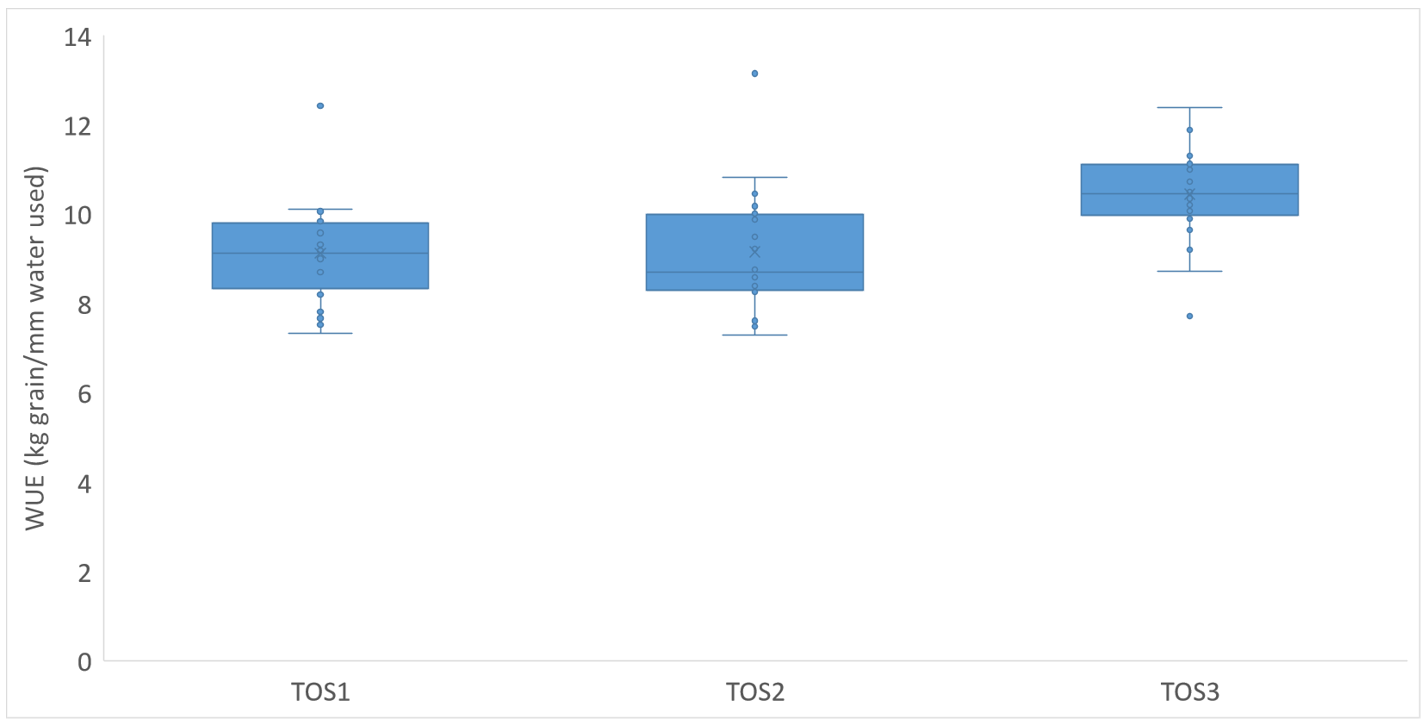
In contrast, water use efficiency was higher from the early planting at Mungindi which also received a significant flood for 3 weeks over the grain fill period. The overall water use efficiency was very high for both times of sowing (Figure 8).
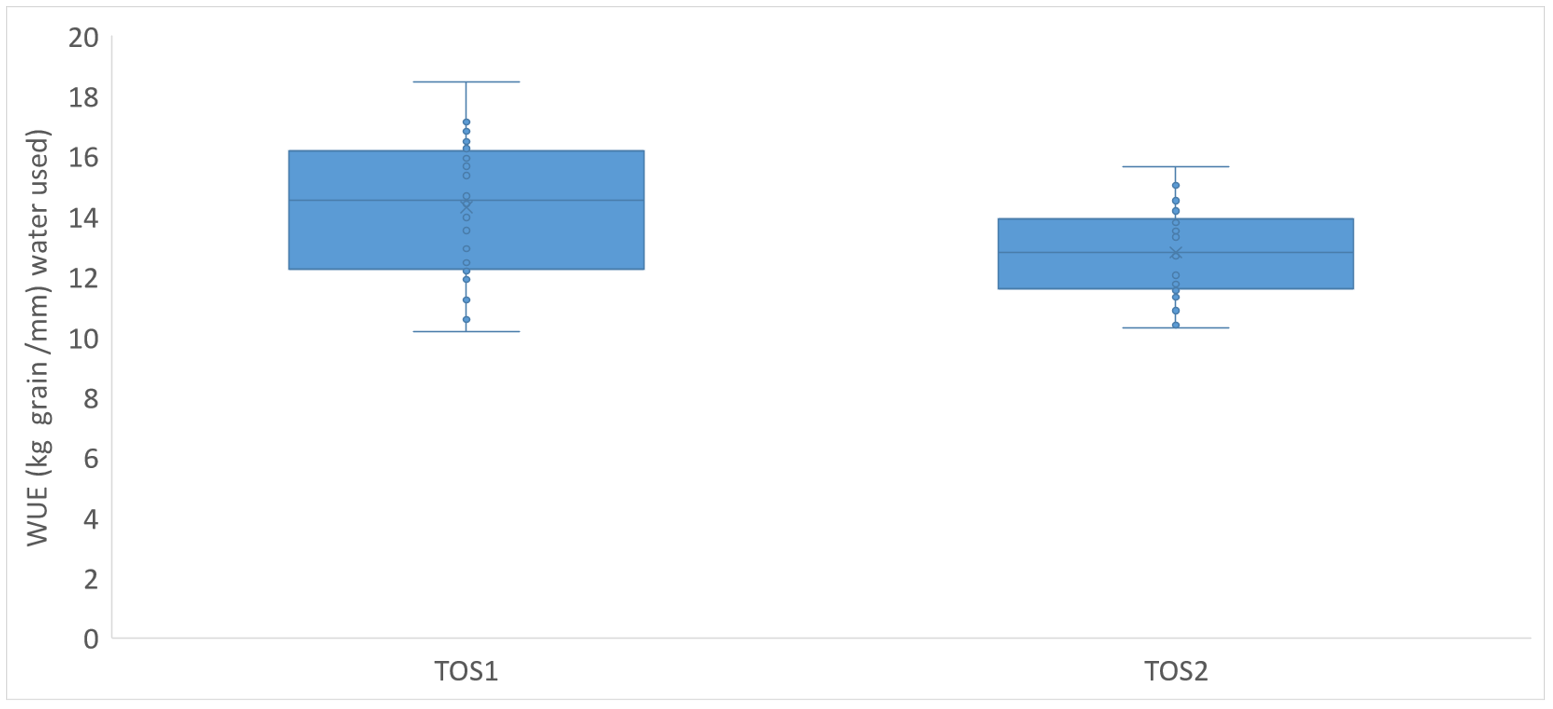
Grain yield and quality
The impact of varying sowing time on grain yield was measured at each of the trial sites from 2018-2020. The range in grain yields from the trial sites was from <1 t/ha up to 12 t/ha under both dryland and irrigated conditions.
Across all these environments and seasons, the yield of early (winter) sown sorghum was similar or higher than that of later sowing dates (Figure 9a). This was associated with higher seed set (Figure 10b) due to a reduced incidence of heat stress around flowering. As grain number is the largest determinant of yield, any strategies which improve seed set are critical to the final crop success.
Grain quality was also improved with early sowing resulting in improved grain size (reduced screenings). This was due to increased availability of soil water later in the season (Figure 9c).
Figure 9. Outcomes from 15 trials sown across the Liverpool Plains, Northern NSW, Darling Downs, Western Downs, and Central Queensland for the 2018/19 and 2019/20 seasons. (a) Mean yields for the three tested times of sowing (winter, spring, and summer); (b) the estimated seed set from the incidence of extreme air temperature events around flowering; and (c) percent screenings. Different italic letters on top of the boxplots indicate statistically significant differences (p<0.05).
Where to next?
As we gain confidence in the practice of early (winter) sowing in sorghum, we need to consider what are the next possible step changes we can adopt which could further improve sorghum productivity and reliability. While most of the focus to date has been on shifting the planting window, there have also been large yield gains demonstrated in this project, achieved through pairing the optimised planting time with a preferred hybrid and plant density.
The 2018-2020 trial set highlights the large variation in yield measured (~66%) across all treatment combinations; hybrids (G), planting times and plant populations (M) (n=3,072), indicating that informing optimum Genetics x Management for each system is critical to maximising crop performance (Figure 10).
The development of regional agronomic packages which identify these combinations will provide valuable information for decision makers. Our ability as an industry to implement these packages to reap the resulting yield and profitability benefits, will be core to ensuring sorghum becomes a viable crop option in marginal areas and its potential is exploited within northern cropping systems.

Conclusions
There are significant opportunities available to optimise sorghum production in Northern NSW and Southern Queensland. The first of these options is to move the sowing window forward as a tool to reduce the risk of heat and moisture stress at anthesis and grain fill.
To date, early sown (winter) sorghum has provided benefits which have far outweighed the risks. The integration of additional tools to help growers develop knowledge on seed quality impacts (germination and vigour), methods to improve plant establishment, prediction of hybrid flowering time and overall crop water use, will improve our confidence in sorghum production.
The optimum management package will suggest avoidance of the peak heat and moisture stress periods in the northern grains region and generate a profitable sorghum grain yield with optimised water use efficiency, whilst still maintaining system benefits such as stubble cover from a cereal crop. This is a significant challenge for the future of our industry, but also a massive opportunity for sorghum production which is waiting to be exploited.
Acknowledgements
The research undertaken as part of this project is made possible by the significant contributions of growers through both trial cooperation and the financing of the GRDC. The authors would like to thank them for their continued support. The authors also acknowledge the collaboration between QDAF, NSW DPI and UQ-QAAFI, and participating technical staff. Thanks also to the participating seed companies for their continued support.
The support of Andrew Earle “Bullawarrie” Mungindi, Tom & Melissa Greentree “Quissisana” Mungindi, Geoff Manchee & JR McDonald “Bogamildi” Moree, Michael Brosnan, B&W Rural Mungindi and the Mungindi Cropping Group and is also gratefully acknowledged.
Contact details
Loretta Serafin
NSW Department of Primary Industries
4 Marsden Park Rd, Tamworth, NSW 2340
Ph: 0427 3118 19
Email: loretta.serafin@dpi.nsw.gov.au
GRDC Project Code: UOQ1808-001RTX,
Was this page helpful?
YOUR FEEDBACK

